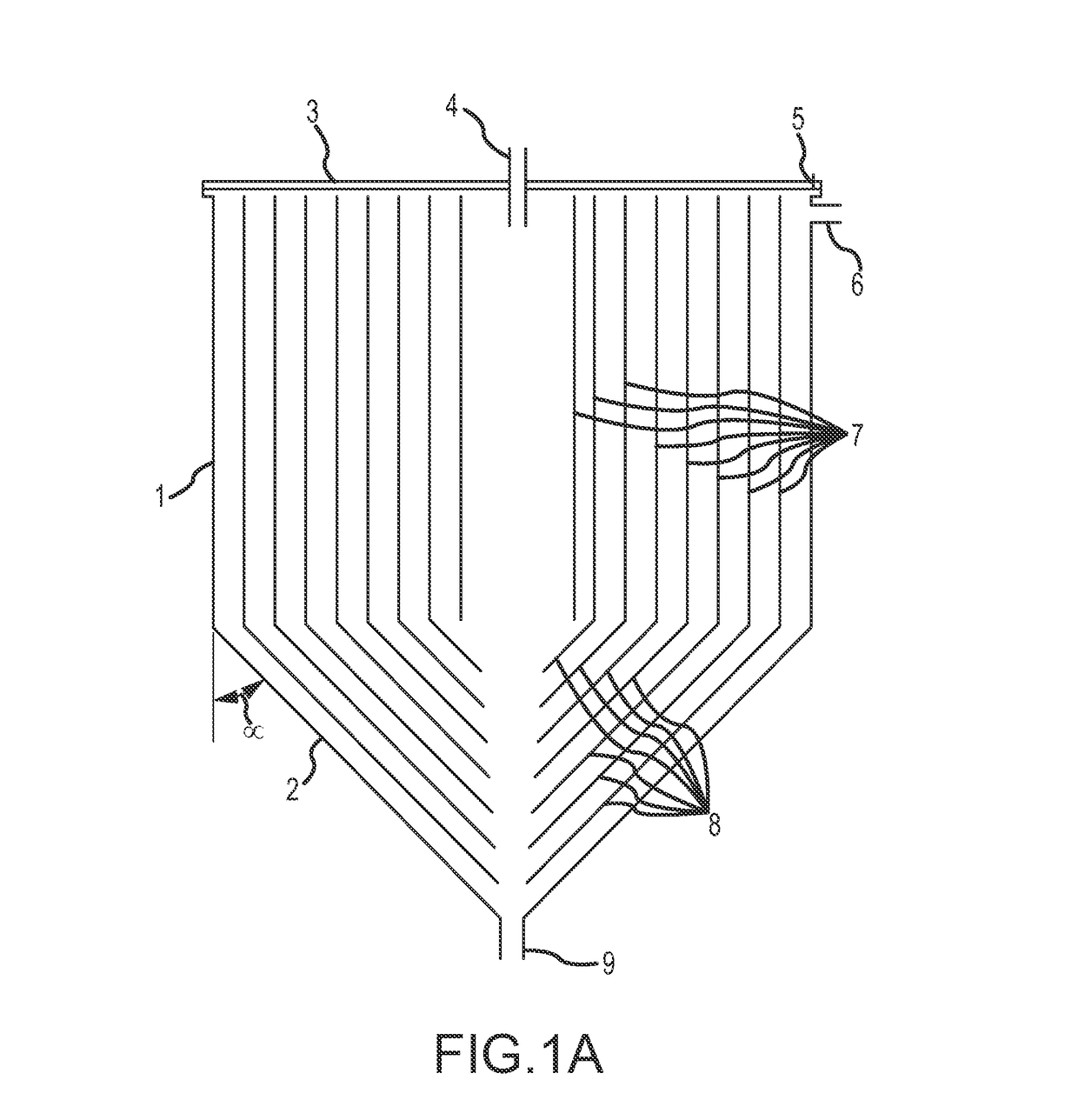Particle settling devices
a particle settling and particle technology, applied in the direction of vortex flow apparatus, separation process, peptides, etc., can solve the problems of insufficient centrifugal force, mammalian cells are seriously damaged at higher flow rate (and centrifugal force), and the separation and collection of biological proteins, polypeptides or hormones secreted from suspension cultures of recombinant microbial or mammalian cells is particularly difficult, so as to improve the settling efficiency of particles
- Summary
- Abstract
- Description
- Claims
- Application Information
AI Technical Summary
Benefits of technology
Problems solved by technology
Method used
Image
Examples
example 1
Yeast or Other Microbial Cells Secreting Protein Products
[0064]Recombinant microbial cells such as yeast or fungal (Pichia pastoris, Saccharomyces cerevisiae, Kluyveromyces lactis, Aspergillus niger, etc.) or bacterial (Escherichia coli, Bacillus subtilis, etc.) cells, which have been engineered to secrete heterologous proteins or naturally secreting enzymes (e.g. A. niger, B. subtilis, etc.) can be grown in bioreactors attached to settler devices of the present disclosure to recycle live and productive cells back to the bioreactor, which will thereby achieve high cell densities and high productivities. Fresh nutrient media is continuously supplied to the live and productive cells inside the high cell density bioreactors and the secreted proteins or enzymes are continuously harvested in the clarified outlet from the top or top-side outlets as shown in FIGS. 5, 6 and 7, while the concentrated live and productive cells are returned back to the bioreactor. As dead cells and a small fra...
example 2
Removing Yeast Cells From Beer
[0065]In large-scale brewing operations, yeast cells are removed from the product beer by filtration devices, which regularly get clogged, or centrifugation devices, which are expensive high-speed mechanical devices. These devices can be readily replaced by the present invention to clarify beer from the top outlets and remove the concentrated yeast cell suspension from the bottom outlet. Hydrocyclones were unsuccessfully tested for exactly this application (Yuan et al., 1996; Cilliers and Harrison, 1997). Due to the increased residence time in the spiral channels and enhanced sedimentation in the conical spiral settler zone of the present invention, we have achieved successful separation of yeast cells from cell culture liquid, harvesting the culture supernatant containing only about 5% of the cells entering the settler device in its first operation. As the device can be scaled up or down to increase or decrease its cell separation efficiency, it is fea...
example 3
Mammalian Cell Perfusion Cultures
[0066]Enhanced sedimentation of recombinant mammalian cells and murine hybridoma cells in inclined settlers have already been demonstrated successfully (Batt et al., 1990 and Searles et al., 1994) and scaled up in lamellar settlers (Thompson and Wilson, U.S. Pat. No. 5,817,505, 1998). While the lamellar settlers are scaled up in three dimensions independently, the present invention of a conical spiral settler device can be scaled up in three dimensions simultaneously by simply increasing its radius, as discussed above. Further, the present invention benefits from an additional cell separating mechanism of increasing centrifugal forces as the cell culture liquid passes through the decreasing radius of the vertical spiral section, followed by the enhanced sedimentation in the conical spiral settling zone of the settler devices of this disclosure. Thus, the settler devices of the present disclosure is a more compact and more easily scalable cell retenti...
PUM
| Property | Measurement | Unit |
|---|---|---|
| angle of inclination | aaaaa | aaaaa |
| angle of inclination | aaaaa | aaaaa |
| width | aaaaa | aaaaa |
Abstract
Description
Claims
Application Information
 Login to View More
Login to View More - R&D
- Intellectual Property
- Life Sciences
- Materials
- Tech Scout
- Unparalleled Data Quality
- Higher Quality Content
- 60% Fewer Hallucinations
Browse by: Latest US Patents, China's latest patents, Technical Efficacy Thesaurus, Application Domain, Technology Topic, Popular Technical Reports.
© 2025 PatSnap. All rights reserved.Legal|Privacy policy|Modern Slavery Act Transparency Statement|Sitemap|About US| Contact US: help@patsnap.com



